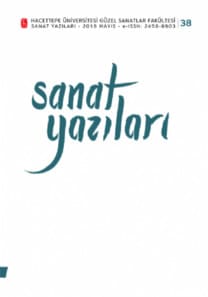SANATTA YARATICILIK VE TEMELLÜK: Yineleme ve Yenilemenin Sanatsal-Yasal Müşterekleri
Temellük, Orijinalite, Hukuk, Telif Hakkı, Yenilik, Yineleme
___
- Bizaki, Magdalini. (2018). Appropriation in Visual Arts: Discoursing with Copyright Law and Managing Sustainability in Museums. (MA in Art, Law and Economy). International Hellenic University, School Of Economics, Business Administration &Legal Studies, Thessaloniki.
- Bourdieu, Pierre. (1993). The Field of Cultural Production. New York: Columbia University Press.
- Buriánková, Zuzana. (2007). Adaptation – Mimesis, Transformation, Interpretation. (Doktora Tezi). Charles University, Faculty of Arts, Institute of English and American Studies, Prague.
- Carver, Gavin., Beardon, Colin. (2004). New Visions in Performance. Carver, Gavin., Beardon, Colin (Eds.). New Visions In Performance: The Impact Of Digital Technologies, s. 167- 182. Exton, PA : Swets & Zeitlinger Publishers.
- Collazo, Cicily J. (2016). The Rules of Appropriation from the Perspective of a Contemporary Artist. (Yüksek Lisans Tezi). Trinity College, Hartford Connecticut.
- Cunliffe, Lesley. (2005). Art and Worldview: Escaping the Formalist and Collectivist Labyrinth. Hickman, Richard. (Ed.). Critical Studies In Art & Design Education, s. 119-137. Bristol, UK. Portland, OR: Intellect Books.
- Eagleton, Terry. (2005). Kültür Yorumları. (Ö. Çelik, Çev.). İstanbul: Ayrıntı Yayınları.
- Featherstone, Mike. (2005). Postmodernizm ve Tüketim Kültürü. (Mehmet Küçük, Çev.). İstanbul: Ayrıntı Yayınları.
- Harrison, Nathanael Karl. (2014). Appropriation Art and U.S. Intellectual Property Law Since 1976. (Doktora Tezi). University of California, San Diego.
- Jusdanis, Gregory. (1998). Gecikmiş Modernlik ve Estetik Kültür. (Tuncay Birkan, Çev.). İstanbul: Metis Yayınları.
- Kuspit, Donald. (2006). Sanatın Sonu. (Yasemin Tezgiden, Çev.). İstanbul: Metis yayınları.
- Landes, William M. (2000). Copyright, Borrowed Images, and Appropriation Art: An Economic Approach. George Mason Law Review, 9(1), s. 1-24.
- Markellou, Marina P. (2013). Appropriation Art and Cultural Institutions. Queen Mary Journal of Intellectual Property, 3(2), s. 145–154.
- Irvin, Sherri. (2005). Appropriation and Authorship in Contemporary Art. The British Journal of Aesthetics, 45(2), s. 123–137.
- Townsley, Jill. (2010). Moments of Repetition in the Process of Art Production: Temporalities, Labour, Appropriations and Authorship. (Yayımlanmamış Doktora Tezi). University of Liverpool, United Kingdom.
- Van Camp, Julie C. (2007). Originality in Postmodern Appropriation Art. The Journal of Arts Management, Law, and Society, 36(4), s. 247-258. DOI: 10.3200/JAML.36.4.247-258.
- Weisberg, Robert W. (2006). Creativity, Understanding Innovation in Problem Solving, Science, Invention, and the Arts. New Jersey: John Wiley & Sons, Inc. Hoboken. Williams, Raymond. (1993). Kültür. (Suavi Aydın Çev.). Ankara: İmge Kitabevi.
- İnternet Kaynakçası
- Abinun, Joseph. (1981). Creativity and Education: Some Critical Remarks. Journal of Aesthetic Education, 15(1), s. 17–29. Erişim: 03.05.2022. https://doi.org/10.2307/3332207
- Cohen, Leonora M. (2012). Adaptation and Creativity in Cultural Context. Revista de Psicología (Lima), 30 (1), s. 3-18 (ISSN 0254-9247) Erişim: 03.05.2022. http://pepsic.bvsalud.org/scielo.php?script=sci_arttext&pid=S0254-92472012000100001&lng=pt&tlng=en.
- Dimock, Marshall. (1986). Creativity. Public Administration Review, 46(1), s. 3–7. Erişim: 03.05.2022. https://doi.org/10.2307/975436
- Francis, Jonathan. (2014). On Appropriation: Cariou v. Prince and Measuring Contextual Transformation in Fair Use. Berkeley Technology Law Journal, 29, s. 681–716. Erişim: 03.05.2022. http://www.jstor.org/stable/24119953
- Gorman, Eric D. (2012). Appropriate Testing and Resolution: How to Determine Whether Appropriation Art is Transformative Fair Use or Merely in Unauthorized Derivative. St. Mary's Law Journal, 43(2), s. 289-332. Erişim: 03.05.2022. https://commons.stmarytx.edu/thestmaryslawjournal/vol43/iss2/1
- Kristeller, Paul Oskar. (1983). “Creativity” and “Tradition.” Journal of the History of Ideas, 44(1), s. 105–113. Erişim: 03.05.2022. https://doi.org/10.2307/2709307
- Peterson, R. A., Anand, N. (2004). The Production of Culture Perspective. Annual Review of Sociology, 30, s. 311–334. Erişim: 03.05.2022. http://www.jstor.org/stable/29737696
- Zwisler, John C. (2016). (Mis)appropriation Art: Transformation and Attribution in the Fair Use Doctrine. Chicago-Kent Journal of Intellectual Property, [online] 15 (1), s. 163-199. Erişim: 03.05.2022. http://heinonline.org/HOL/Page?handle=hein.journals/jointpro15&collection=journals &id=163&startid=&endid=200
- ISSN: 2458-8903
- Yayın Aralığı: Yılda 2 Sayı
- Başlangıç: 2001
- Yayıncı: -
SİVİL TOPLUM VE FEMİNİST SANAT: CİNSİYET EŞİTSİZLİĞİNE KARŞI TOPLUMSAL BİLİNCİN İNŞASI
“ISLATMA-LEKELEME” TEKNİĞİYLE GELİŞEN HELEN FRANKENTHALER ESERLERİNDE BOYA VE YÜZEY KULLANIMI
HASTANE İÇ MEKAN ÇOCUK OYUN ALANLARI TASARIM YAKLAŞIMI
ÇAĞDAŞ RESİM SANATINDA NEO-EKSPRESYONİZM EĞİLİMİ: IKB/ERBİL ÖRNEĞİ (1991-2015)
ORTA ÇAĞ'DA DOĞA ve BİTKİ TEMSİLLERİ: MAHLUKATNAMELERDEN HERBARYUMLARA GEÇİŞ
Huri KİRİŞ BÜYÜKGÜNER, Emine Begüm SAVÇIN
TOPLUMCU GERÇEKÇİLİK VE MÜZİK: ŞOSTAKOVİÇ’İN CAZ ORKESTRASI İÇİN SUİT NO. 1 ve 2'DEN VALS ÖRNEĞİ
CHRISTIAN BOLTANSKI’NİN SANATINDA ÖLÜMDEN ARDA KALAN: ANIT, ARŞİV VE HAFIZA
SANATTA PENCERE- ÇERÇEVE METAFORU ÜZERİNDEN OLAY ÖRGÜSÜNDE GEDİKLER
SANATTA YARATICILIK VE TEMELLÜK: Yineleme ve Yenilemenin Sanatsal-Yasal Müşterekleri
